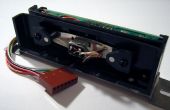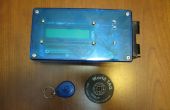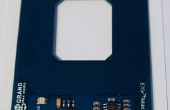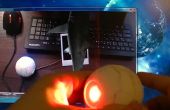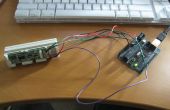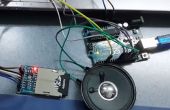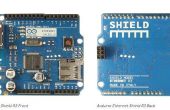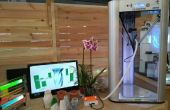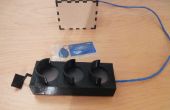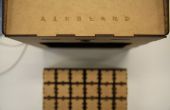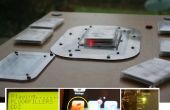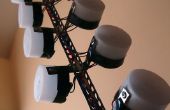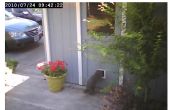Paso 8: Sketch de Arduino archivo
El siguiente archivo de Arduino Sketch hace el Arduino esperar una línea desde el equipo host. Si la línea en es "Leer todos", el Arduino haga lo siguiente:
- Envíe un "Inicio:" línea al ordenador.
- Leer todos los datos del cartucho y enviarlo al ordenador en HEX, un byte por línea.
- Enviar un ": fin" línea al ordenador.
Una vez que los datos del cartucho ha sido enviados al ordenador, el Arduino está listo para su siguiente comando desde el equipo host.
// ColecoVision / ADAM Cartridge Reader // for the Arduino UNO // 2014-11-25 //---------------------------------------------------------------------------------- // Arduino Pins const int gcChipSelectLine[4] = { A0, A1, A2, A3 }; const int gcShiftRegisterClock = 11; const int gcStorageRegisterClock = 12; const int gcSerialAddress = 10; const int gcDataBit[8] = { 2, 3, 4, 5, 6, 7, 8, 9 }; // Shifts a 16-bit value out to a shift register. // Parameters: // dataPin - Arduino Pin connected to the data pin of the shift register. // clockPin - Arduino Pin connected to the data clock pin of the shift register. //---------------------------------------------------------------------------------- void shiftOut16(int dataPin, int clockPin, int bitOrder, int value) { // Shift out highbyte for MSBFIRST shiftOut(dataPin, clockPin, bitOrder, (bitOrder == MSBFIRST ? (value >> 8) : value)); // shift out lowbyte for MSBFIRST shiftOut(dataPin, clockPin, bitOrder, (bitOrder == MSBFIRST ? value : (value >> 8))); } // Select which chip on the cartridge to read (LOW = Active). // Use -1 to set all chip select lines HIGH. //---------------------------------------------------------------------------------- void SelectChip(byte chipToSelect) { for(int currentChipLine = 0; currentChipLine < 4; currentChipLine++) { digitalWrite(gcChipSelectLine[currentChipLine], (chipToSelect != currentChipLine)); } } // Set Address Lines //---------------------------------------------------------------------------------- void SetAddress(unsigned int address) { SelectChip(-1); // Disable shift register output while loading address digitalWrite(gcStorageRegisterClock, LOW); // Write Out Address shiftOut16(gcSerialAddress, gcShiftRegisterClock, MSBFIRST, address); // Enable shift register output digitalWrite(gcStorageRegisterClock, HIGH); int chipToSelect; if (address < 0xA000) { chipToSelect = 0; } else if (address < 0xC000) { chipToSelect = 1; } else if (address < 0xE000) { chipToSelect = 2; } else { chipToSelect = 3; } SelectChip(chipToSelect); } // Read data lines //---------------------------------------------------------------------------------- void ReadDataLines() { const char cHexLookup[16] = { '0', '1', '2', '3', '4', '5', '6', '7', '8', '9', 'A', 'B', 'C', 'D', 'E', 'F'}; int highNibble = 0; int lowNibble = 0; boolean dataBits[8]; char byteReadHex[4]; for(int currentBit = 0; currentBit < 8; currentBit++) { dataBits[currentBit] = digitalRead(gcDataBit[currentBit]); } highNibble = (dataBits[7] << 3) + (dataBits[6] << 2) + (dataBits[5] << 1) + dataBits[4]; lowNibble = (dataBits[3] << 3) + (dataBits[2] << 2) + (dataBits[1] << 1) + dataBits[0]; Serial.write(cHexLookup[highNibble]); Serial.write(cHexLookup[lowNibble]); Serial.println(); } // Read all of the data from the cartridge. //---------------------------------------------------------------------------------- void ReadCartridge() { unsigned int baseAddress = 0x8000; Serial.println("START:"); // Read Current Chip (cartridge is 32K, each chip is 8k) for (unsigned int currentAddress = 0; currentAddress < 0x8000; currentAddress++) { SetAddress(baseAddress + currentAddress); ReadDataLines(); } Serial.println(":END"); } // Returns the next line from the serial port as a String. //---------------------------------------------------------------------------------- String SerialReadLine() { const int BUFFER_SIZE = 81; char lineBuffer[BUFFER_SIZE]; int currentPosition = 0; int currentValue; do { // Read until we get the next character do { currentValue = Serial.read(); } while (currentValue == -1); // ignore '\r' characters if (currentValue != '\r') { lineBuffer[currentPosition] = currentValue; currentPosition++; } } while ((currentValue != '\n') && (currentPosition < BUFFER_SIZE)); lineBuffer[currentPosition-1] = 0; return String(lineBuffer); } // Indicate to remote computer Arduino is ready for next command. //---------------------------------------------------------------------------------- void ReadyForCommand() { Serial.println("READY:"); } void setup() { // Setup Serial Monitor Serial.begin(57600); // Setup Chip Select Pins for(int chipLine = 0; chipLine < 4; chipLine++) { pinMode(gcChipSelectLine[chipLine], OUTPUT); } // Setup Serial Address Pins pinMode(gcShiftRegisterClock, OUTPUT); pinMode(gcStorageRegisterClock, OUTPUT); pinMode(gcSerialAddress, OUTPUT); // Setup Data Pins for(int currentBit = 0; currentBit < 8; currentBit++) { pinMode(gcDataBit[currentBit], INPUT_PULLUP); } while (!Serial) { ; // wait for serial port to connect. Needed for Leonardo only. } // Reset Output Lines SetAddress(0); ReadyForCommand(); } void loop() { if (Serial.available() > 0) { String lineRead = SerialReadLine(); lineRead.toUpperCase(); if (lineRead == "READ ALL") { ReadCartridge(); } // lineRead = "Read All" ReadyForCommand(); } // Serial.available } Si tienes suerte que suficiente para usar una placa Arduino con 29 o más digital I/O pins (e.g. debido de Arduino, Arduino MEGA ADK, Arduino Mega 2560, etc.) y usted no está usando el cambio de registro de circuito, la función SetAddress en el archivo de dibujo anterior necesitará volver a escribir.
